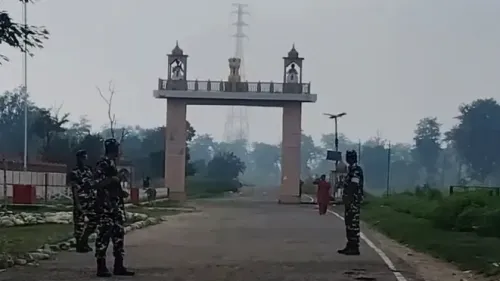Is NDA Set for a Dominant Victory in Bihar's Assembly Elections?

Synopsis
Key Takeaways
- The NDA is projected to lead in four out of five major regions in Bihar.
- Seemanchal is the only region where the MGB holds an advantage.
- The exit poll indicates a strong preference for the NDA across multiple regions.
- Vote consolidation among minorities in Seemanchal benefits the MGB.
- The final results will confirm the accuracy of these projections.
New Delhi/Patna Nov 11 (NationPress) The National Democratic Alliance seems set for a decisive victory in various regions of Bihar following the recent 2025 Assembly elections, as indicated by the Matrize News Communications exit poll released on Tuesday.
With a projected statewide vote share of 48.4 percent equating to 147 to 167 seats, the NDA is firmly in the lead in four out of five major regions, while the Mahagathbandhan (MGB) struggles to maintain its foothold, particularly in Seemanchal.
In Mithilanchal, which consists of 71 seats, the NDA is anticipated to win around 50 to 55 seats with a vote share of 47.7 percent, leaving the MGB with 18 to 23 seats at 36.5 percent. This region, known for its rich cultural and linguistic heritage, consistently supports the ruling coalition.
In Magadh, which includes 51 constituencies, the NDA leads with a forecast of 30 to 35 seats and 48.8 percent of the vote, while the MGB trails with 17 to 22 seats and 36.2 percent. Bhojpur, the largest region with 67 seats, reflects similar trends, with the NDA expected to secure 37 to 42 seats and 48.4 percent votes compared to the MGB’s 20 to 25 seats at 36.1 percent.
The eastern region of Angika, covering 30 seats, also displays a strong inclination towards the NDA, projected to win 20 to 23 seats with a 47.9 percent vote share, while the MGB is estimated to gain 7 to 10 seats at 37.1 percent.
Conversely, Seemanchal is the only area where the MGB appears to have an advantage. With 24 seats, the opposition alliance is anticipated to win 8 to 10 seats with a significant 49.9 percent vote share, whereas the NDA is projected to secure 10 to 12 seats despite obtaining 39.1 percent of the votes. The remaining 2 to 3 seats are likely to go to other parties, reflecting the region's unique socio-political dynamics and the influence of minority voters.
Overall, across Bihar’s 243 Assembly constituencies, the NDA’s regional dominance is relatively uniform except for Seemanchal, where there appears to be a consolidation of votes among Muslim and backward communities that has benefited the MGB.
The exit poll was conducted from November 6 to 11 using random sampling and CATI methods, surveying 66,087 individuals and carrying a margin of error of 3 percent. The survey underscores the NDA’s broad appeal across Angika, Bhojpur, Magadh, and Mithilanchal, fueled by narratives of development and governance continuity.
In contrast, Seemanchal continues to be a bastion of resistance for the ruling parties, highlighting persistent regional divides in Bihar’s electoral landscape. The final results, expected soon, will reveal if these projections are accurate.









